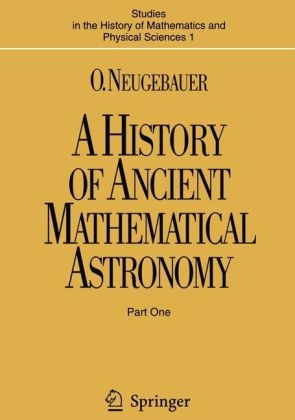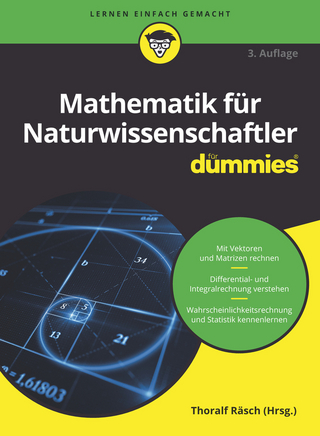
A History of Ancient Mathematical Astronomy
Springer Berlin (Verlag)
978-3-642-61912-0 (ISBN)
- Titel ist leider vergriffen;
keine Neuauflage - Artikel merken
"This monumental work will henceforth be the standard interpretation of ancient mathematical astronomy. It is easy to point out its many virtues: comprehensiveness and common sense are two of the most important. Neugebauer has studied profoundly every relevant text in Akkadian, Egyptian, Greek, and Latin, no matter how fragmentary; [.] With the combination of mathematical rigor and a sober sense of the true nature of the evidence, he has penetrated the astronomical and the historical significance of his material. [.] His work has been and will remain the most admired model for those working with mathematical and astronomical texts.
D. Pingree in Bibliotheca Orientalis, 1977
". a work that is a landmark, not only for the history of science, but for the history of scholarship. HAMA [History of Ancient Mathematical Astronomy] places the history of ancient Astronomy on a entirely new foundation. We shall not soon see its equal.
N.M. Swerdlow in Historia Mathematica, 1979
One.- § 1. Limitations.- § 2. The Major Historical Periods, An Outline.- A. The Hellenistic Period.- B. The Roman Period.- C. Indian Astronomy.- D. The Islamic Period.- E. Epilogue.- § 3. General Bibliography.- A. Source Material.- B. Modern Literature.- C. Sectional Bibliographies.- Book I The Almagest and its Direct Predecessors.- A. Spherical Astronomy.- §1 Plane Trigonometry.- 1. Chords.- 2. The Table of Chords.- 3. Examples.- 4. Summary.- §2. Spherical Trigonometry.- 1. The Menelaos Theorem.- 2. Supplementary Remarks.- §3. Equatorial and Ecliptic Coordinates.- 1. Solar Declinations.- 2. Right Ascensions.- 3. Transformation from Ecliptic to Equatorial Coordinates.- §4. Geographical Latitude; Length of Daylight.- 1. Oblique Ascensions.- 2. Symmetries.- 3. Ascensional Differences.- 4. Ortive Amplitude.- 5. Paranatellonta.- 6. Length of Daylight; Seasonal Hours.- 7. Geographical Latitude; Shadow Table.- §5. Ecliptic and Horizon Coordinates.- 1. Introductory Remarks.- 2. Angles between Ecliptic and Horizon.- 3. Ecliptic and Meridian.- 4. Ecliptic and Circles of Altitude.- 5. The Tables (Alm. II, 13).- B. Lunar Theory.- §1. Solar Theory.- 1. The Length of the Year.- 2. Mean Motion.- 3. Anomaly.- A. Eccenter and Epicycles.- B. Determination of Eccentricity and Apogee.- C. The Table for the Solar Anomaly and its Use.- §2. Equation of Time.- 1. The Formulation in the Almagest (III, 9).- 2. Examples.- 3. Proof of Ptolemy’s Rule.- 4. The Equation of Time as Function of the Solar Longitude.- §3. Theory of the Moon. First Inequality; Latitude.- 1. Introduction.- 2. Mean Motions.- 3. Period of the Lunar Anomaly.- 4. Radius and Apogee of the Epicycle.- A. Summary of the Method.- B. Numerical Data and Results.- C. Check of the Mean Anomaly; Epoch Values.- 5. The Tables for the First Inequality.- 6. Latitude.- A. Mean Motion of the Argument of Latitude.- B. Epoch Value for the Argument of Latitude.- C. The Lunar Latitude; Example.- §4. Theory of the Moon. Second Inequality.- 1. Empirical Data and Ptolemy’s Model.- 2. Determination of the Parameters.- A. Maximum Equation; Eccentricity.- B. “Inclination”.- C. Critical Remarks.- 3. Computation of the Second Inequality; Tables.- 4. Syzygies.- §5. Parallax.- 1. Introduction.- 2. The Distance of the Moon.- 3. Apparent Diameter of the Moon and of the Sun.- A. Ptolemy’s Procedure.- B. Criticism.- 4. Size and Distance of the Sun.- A. Hipparchus’ Procedure.- B. Historical Consequences.- 5. The Table for Solar and Lunar Parallax (Alm. V, 18).- 6. The Components of the Parallax.- §6. Theory of Eclipses.- 1. Determination of the Mean Syzygies.- 2. Determination of the True Syzygies.- 3. Eclipse Limits.- 4. Intervals between Eclipses.- 5. Tables (VI, 8).- 6. Area-Eclipse-Magnitudes.- 7. Angles of Inclination.- C. Planetary Theory.- §1. Introduction.- 1. General.- 2. Distances and Eccentricities.- 3. Ptolemy’s Introduction to Almagest IX.- 4. Parameters of Mean Motion.- §2. Venus.- 1. Eccentricity and Equant.- 2. Mean Motion in Anomaly. Epoch.- 3. The Observational Data.- §3. Mercury.- 1. Apogee.- 2. Eccentricity and Equant.- 3. Perigees.- 4. Mean Motion in Anomaly. Epoch.- 5. Minimum Distance and Motion of the Center of the Epicycle.- §4. The Ptolemaic Theory of the Motion of an Outer Planet.- 1. The Basic Ideas.- 2. Refinement of the Model.- 3. Determination of the Eccentricity and Apogee.- A. Eccentricity from Oppositions.- B. Approximative Solution.- C. Separation of Equant and Deferent.- D. Results.- 4. The Size of the Epicycle.- 5. Mean Motion in Anomaly.- 6. Epoch Values.- §5. Planetary Tables.- 1. The General Method.- 2. Numerical Data.- 3. Examples.- A. Ephemeris for Mars.- B. Ephemeris for Venus.- §6. Theory of Retrogradation.- 1. Stationary Points.- A. Mean Distance.- B. Maximum Distance.- C. Minimum Distance.- D. Numerical Data.- 2. Tables for Retrogradations.- A. Epicycle at Extremal Distances.- B. Epicycle at Arbitrary Distances; Tables.- C. Examples.- §7. Planetary Latitudes.- 1. The Basic Theory.- 2. Numerical Data.- A. The Outer Planets.- B. The Inner Planets.- 3. The Tables Alm. XIII, 5.- A. Outer Planets.- B. Inner Planets.- C. Extremal Latitudes.- D. Transits.- §8. Heliacal Phenomena (“Phases”).- 1. Maximum Elongations.- A. Venus.- B. Mercury.- C. The Tables (Alm. XII, 10).- 2. The “Normal Arcus Visionis”.- A. Ptolemy’s Procedure.- B. Numerical Details.- 3. Extremal Cases for Venus and Mercury.- A. Venus.- B. Mercury.- 4. The Tables (Alm. XIII, 10).- A. Example.- B. Method of Computing the Tables.- 5. The Planetary Phases in the Handy Tables and Other Sources.- D. Apollonius.- §1. Biographical Data.- §2. Equivalence of Eccenters and Epicycles.- 1. Transformation by Inversion.- 2. Lunar Theory.- §3. Planetary Motion; Stationary Points.- 1. Apollonius’ Theorem for the Stations.- 2. Empirical Data.- E. Hipparchus.- §1. Introduction.- §2. Fixed Stars. The Length of the Year.- 1. Stellar Coordinates. Catalogue of Stars.- A. Stellar Coordinates.- B. Hipparchus’ and Ptolemy’s Catalogue of Stars.- C. Catalogue of Stars. Continued.- D. Stellar Magnitudes.- 2. The Length of the Year. Precession.- A. Tropical and Sidereal Year.- B. Intercalation Cycles.- C. Constant of Precession; Trepidation.- §3. Trigonometry and Spherical Astronomy.- 1. Plane Trigonometry; Table of Chords.- 2. Spherical Astronomy.- §4. Solar Theory.- §5. The Theory of the Moon.- 1. The Fundamental Parameters.- A. Period Relations.- B. The Draconitic Month.- C. The Epicycle Radius.- 2. Eclipses.- A. Tables.- B. Eclipse Cycles and Intervals.- 3. Parallax.- 4. Size and Distance of Sun and Moon.- A. Distance of the Sun.- B. Hipparchus’ Procedure.- §6. Additional Topics.- 1. The Planets.- 2. Astrology.- 3. Geography.- A. Geographical Latitude.- B. Longitudes.- 4. Fragments.- §7. Hipparchus’ Astronomy. Summary.- Book II Babylonian Astronomy.- §1. The Decipherment of the Astronomical Texts.- §2. The Sources.- §3. Calendaric Concepts.- 1. The 19-Year Cycle.- 2. Solstices and Equinoxes.- 3. Sirius Dates.- 4. Summary.- §4. Length of Daylight.- 1. Oblique Ascensions.- 2. Length of Daylight.- §5. Solar Motion.- §6. Mathematical Methodology.- 1. System B.- 2. System A.- A. Planetary Theory.- §1. Basic Concepts.- §2. Periods and Mean Motions.- §3. System A.- §4. Dates.- §5. Subdivision of the Synodic Arc; Daily Motion.- 1. Subdivision of the Synodic Arc.- A. Jupiter.- B. Mars.- C. Mercury.- 2. Subdivision of the Synodic Time; Velocities.- A. Summary; Jupiter.- B. Mars.- 3. Daily Motion.- A. Jupiter.- B. Mercury.- §6. The Fundamental Patterns of Planetary Theory.- 1. System A.- A. Numerical Data.- B. Subdivision of the Synodic Arc.- C. Approximate Periods.- 2. System B.- 3. Historical Reminiscences.- §7. The Single Planets.- 1. Introduction.- 2. Saturn.- A. System A.- B. System B.- C. Subdivision of the Synodic Arc; Daily Motion.- 3. Jupiter.- A. System A.- B. System B.- C. Subdivision of the Synodic Arc.- D. Daily Motion.- 4. Mars.- A. Periods; System A.- B. System B.- C. Subdivision of the Synodic Arc; Retrogradation.- 5. Venus.- A. Periods.- B. Ephemerides.- 6. Mercury.- A. Periods.- B. System A1 to A3.- B. Lunar Theory.- §1. Introduction.- §2. Lunar Velocity.- 1. System B.- 2. System A.- 3. Daily Motion.- 4. Summary.- §3. The Length of the Synodic Months.- 1. System B, Column G.- 2. System A, Columns ? and G.- A. The Function ?.- B. Column G near the Extrema.- C. The Function G.- 3. System A, Column J.- 4. System A, Columns C’, K, and M.- 5. System B, Columns H to M.- A. Summary.- B. Columns Hand J.- C. Column M.- §4. The “Saros” and Column ?.- 1. The Functions ?* and F*.- 2. The Saros.- 3. ?, Friends and Relations.- A. Summary.- B. Mathematical Methodology.- C. Numerical Details.- §5. Lunar Latitude.- 1. Retrogradation of the Lunar Nodes.- 2. System A, Column E.- 3. The Saros.- 4. Other Latitude Functions.- §6. Eclipse Magnitudes.- 1. System A.- 2. System B.- §7. Eclipse Tables.- §8. Solar Mean Motion and Length of Year.- §9. Variable Solar Velocity.- 1. Type A and B.- 2. System A and A?.- 3. System B.- §10. Visibility.- 1. The Date of the Syzygies.- 2. First Visibility.- 3. Last Visibility and Full Moons.- 4. Visibility Conditions.- C. Early Babylonian Astronomy.- §1. Calendaric Data, Celestial Coordinates.- §2. The Moon.- §3. The Planets.
| Erscheint lt. Verlag | 3.10.2013 |
|---|---|
| Reihe/Serie | Studies in the History of Mathematics and Physical Sciences ; 1 |
| Zusatzinfo | LXIII, 1456 p. In 3 volumes, not available separately. |
| Verlagsort | Berlin |
| Sprache | englisch |
| Maße | 170 x 244 mm |
| Gewicht | 986 g |
| Themenwelt | Mathematik / Informatik ► Mathematik ► Allgemeines / Lexika |
| Mathematik / Informatik ► Mathematik ► Geschichte der Mathematik | |
| Naturwissenschaften ► Physik / Astronomie ► Astronomie / Astrophysik | |
| Schlagworte | Altertum /Naturwissenschaften • Apollonius • Astronomie • Astronomy • History • History of Mathematics • History of Scholarship • History of Science |
| ISBN-10 | 3-642-61912-6 / 3642619126 |
| ISBN-13 | 978-3-642-61912-0 / 9783642619120 |
| Zustand | Neuware |
| Haben Sie eine Frage zum Produkt? |
aus dem Bereich


